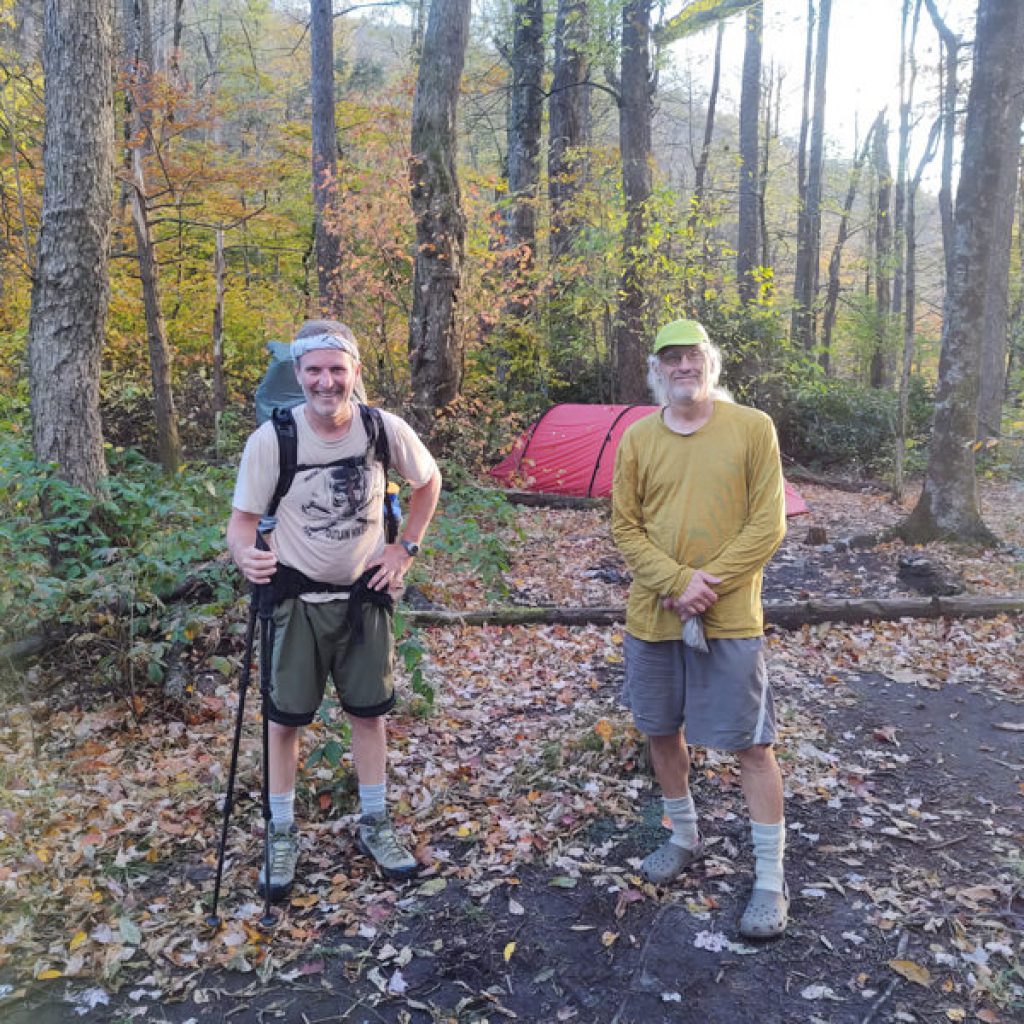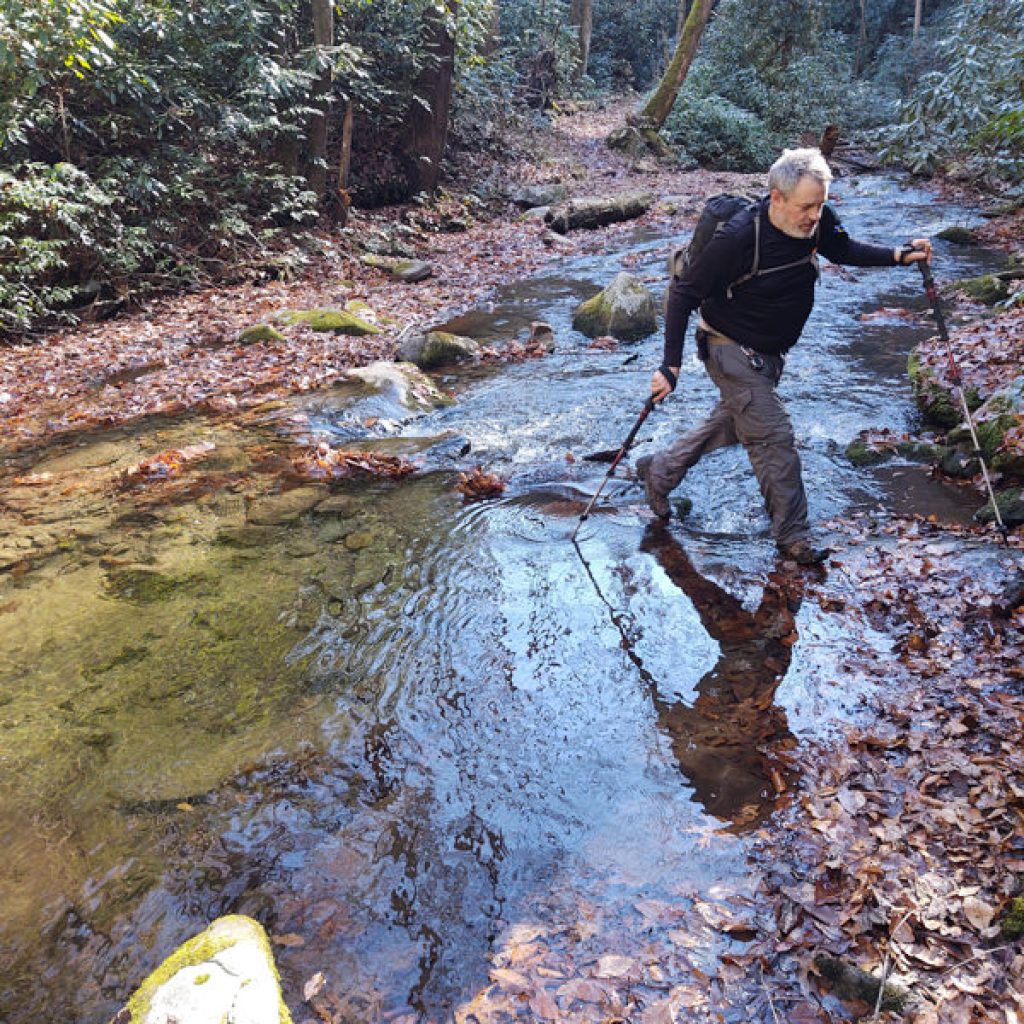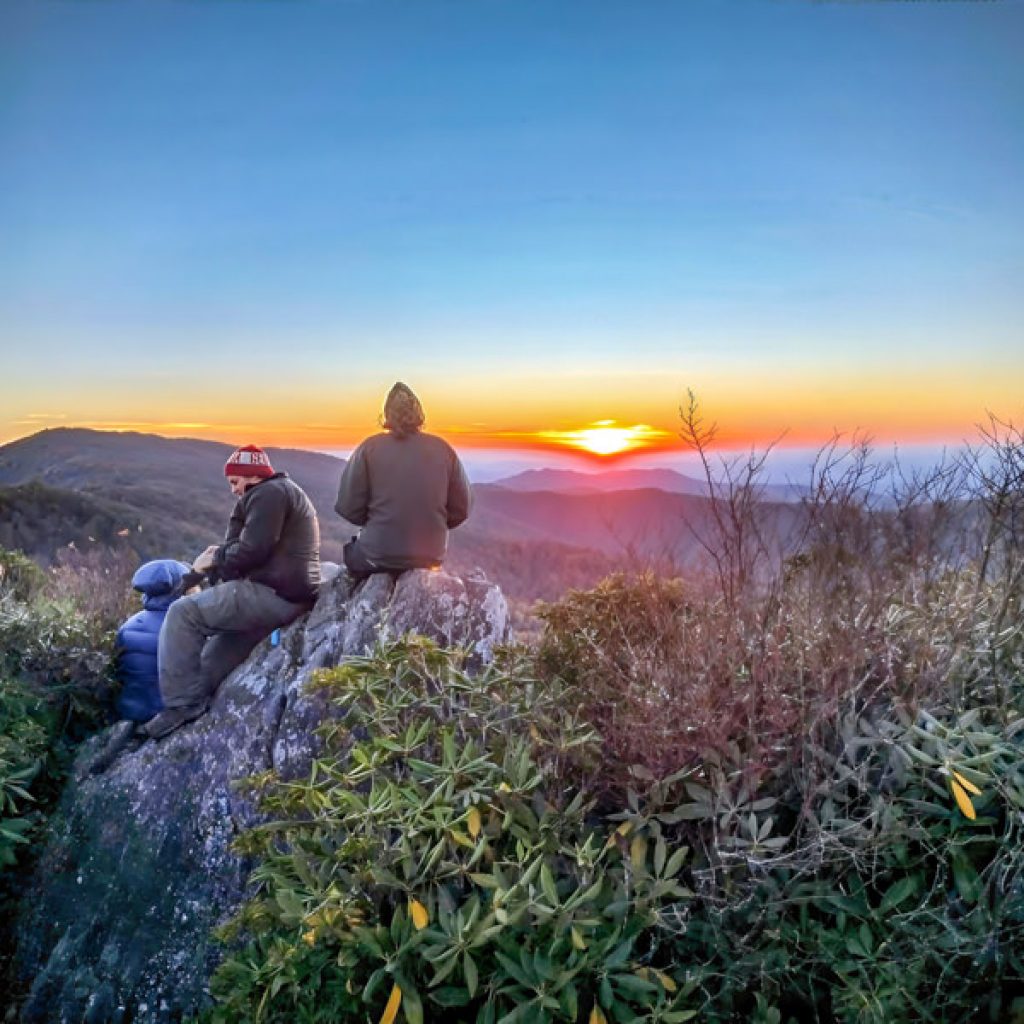In search of a lost hunter, a trek through
Jeffrey’s Hell reveals not just legend, but the fragile edge of America’s last great wild places.
Story and Photography by John Quillen
Appeared in Cityview Magazine, Vol. 41, Issue 6 (Nov/Dec 2025)
Many legends float through the Citico/ Slick Rock wilderness. Deep in the folds of this magical place are paths few have ever crossed. Had the controversial Cherahola Skyway never been constructed, this would remain the largest tract of roadless wilderness on the East Coast.
I set off on a quest to disappear into the heart of this vastness one time. My goal was to chase the ghost of Ebenezer Jeffrey. Legend has it he disappeared chasing his hounds into these hills and hollers. At the turn of the 1900s, locals would say you could hear him on a clear night still calling for those dogs; neither of which ever returned. If you stick a pin in a map on the Citico side, it will put you squarely in a place delineated as Jeffrey’s Hell. And that is where I wound up.

Southern mountain people referred to laurel and heath slicks as hells. Ask anyone who has ever been trapped in dog hobble and saw briers. Those were our reward as I spent my first day following the creek. I was on the Jeffrey’s Hell trail but there was nothing particularly sinister or hellish about this one. By the time we got to the South Fork Citico Trail, my first danger appeared in the form of a huge swollen crossing. It seemed wise to camp here for the night in hopes the flow may abate by morning.
But it did not. By dawn my friend and I were thigh deep in a raging torrent when he suddenly lost his footing and hiking pole. Quick thinking and a bit of teamwork saved the day. Ebenezer Jeffrey was sending us a message.
The wilderness of Citico is unmarked. Occasionally there may dangle a derelict sign but no such luck for Brush Mountain on this day. I did notice a piece of red tape attached to a tree on the opposite side of the creek. This jived with my reading of an antiquated paper map. I had a faint idea who may have left that tape. There’s another legend that cruises around these parts. His name is Tipi Walter.
Tipi is known to set off for three weeks at a time, with a pack sometimes weighing up to 75 lbs. I first met him 18 years ago while I was camped at a place called Mill-Branch. He came lumbering into my area with his dog and this monstrous backpack. My group had been waging a big fight with the forest service over their abominable decimation at Saddle Tree Gap not far away on the Carolina side. For no apparent reason they had clear cut more than 100 mature beech and birch trees at my favorite camping spot on earth.
Tipi was down for the fight and threw his hat into the ring with us. After all, this was like home to him. I learned a valuable lesson when dealing with public lands managers: when something is done, it’s done. Despite our offer to carry saplings up there to reforest the area, we were similarly dispatched by a bureaucratic sawblade. What remains today is a shameful patch of weeds and briers.
Annually my group of friends return to that place up near the Haoe. It’s probably the most beautiful view in the south, minus the clear cut. What I have noticed in the 40 years I’ve been going up there, however, is the encroaching civilization noise. This is because of the Skyway. Although 10 miles away, those Harley-Davidson noises permeate the forest. And I say this as a motorcycle rider myself. Tipi and I would sit up there on that knob looking out over three states. Sunset and sunrise are spectacular at The Hangover. What used to be identifiable little spots of light from Tellico, Madisonville, and Maryville, have turned into an unbroken string from one end to the other.

As I bushwhacked up the Brush Mountain Trail, it was apparent no one had been here since Tipi. I just sensed it. He was the only soul willing to clip out overhanging vines and laurel. We were circumnavigating a mountain called Ike’s Peak. Deep in this wilderness—and now obviously off-trail, Jeffrey’s Hell was sucking us deeper and deeper into no-man’s-land. Any logging roads that may have brought someone into this area had been closed off thanks to the unusual wisdom of bipartisan lawmakers in the form of the Roadless Act in 2001.
When I next saw Tipi in the fall, he knew exactly where we had been. No one ever goes up or down Brush Mountain without a great story. Most don’t end up three days long though.
Our second night found us camping along the raging torrent of South Fork Citico. Another big crossing and seven or eight miles was required before we would reach the Skyway and our vehicle. Despite the cuts and abrasions I was thankful for the wild unpredictability of this area.
When Tipi disappears on his three-week trips into this wilderness he often takes a book and burns chapters as he reads them. A man in his seventies needs to lighten his load wherever possible. Thoreau opined, “I should be glad if all the meadows on the earth were left in a wild state, if that were the consequence of men’s beginning to redeem themselves”.
We’re faced with an obvious clear and present danger in the form of potential changes to the roadless rule designation. The entire magic of Citico and Slick Rock could disappear into memory. Wilderness is medicine and solitude healing. John Muir knew this when he drug Teddy Roosevelt off up in Yosemite. Roosevelt was being feted by the corporate interests to turn that area into development for commercial purposes. Leaning against a Sequoia in the light of their golden campfire, Muir convinced our president to enshrine the areas and hence was born the National Park system. Who would have imagined 122 years later we would need to drag some more politicians back into the warming glow beneath an unspoiled canopy.
If this roadless designation is revoked, it’s not just Citico/Slick Rock that are threatened. Nearly 58.5 million acres are at risk nationally. On behalf of the forest, I ask for your help. Tipi does too. M
any legends float through the Citico/ Slick Rock wilderness. Deep in the folds of this magical place are paths few have ever crossed. Had the controversial Cherahola Skyway never been constructed, this would remain the largest tract of roadless wilderness on the East Coast.
I set off on a quest to disappear into the heart of this vastness one time. My goal was to chase the ghost of Ebenezer Jeffrey. Legend has it he disappeared chasing his hounds into these hills and hollers. At the turn of the 1900s, locals would say you could hear him on a clear night still calling for those dogs; neither of which ever returned. If you stick a pin in a map on the Citico side, it will put you squarely in a place delineated as Jeffrey’s Hell. And that is where I wound up.
Southern mountain people referred to laurel and heath slicks as hells. Ask anyone who has ever been trapped in dog hobble and saw briers. Those were our reward as I spent my first day following the creek. I was on the Jeffrey’s Hell trail but there was nothing particularly sinister or hellish about this one. By the time we got to the South Fork Citico Trail, my first danger appeared in the form of a huge swollen crossing. It seemed wise to camp here for the night in hopes the flow may abate by morning.
But it did not. By dawn my friend and I were thigh deep in a raging torrent when he suddenly lost his footing and hiking pole. Quick thinking and a bit of teamwork saved the day. Ebenezer Jeffrey was sending us a message.
The wilderness of Citico is unmarked. Occasionally there may dangle a derelict sign but no such luck for Brush Mountain on this day. I did notice a piece of red tape attached to a tree on the opposite side of the creek. This jived with my reading of an antiquated paper map. I had a faint idea who may have left that tape. There’s another legend that cruises around these parts. His name is Tipi Walter.
Tipi is known to set off for three weeks at a time, with a pack sometimes weighing up to 75 lbs. I first met him 18 years ago while I was camped at a place called Mill-Branch. He came lumbering into my area with his dog and this monstrous backpack. My group had been waging a big fight with the forest service over their abominable decimation at Saddle Tree Gap not far away on the Carolina side. For no apparent reason they had clear cut more than 100 mature beech and birch trees at my favorite camping spot on earth.

Tipi and I would sit up there on that knob looking out over three states. Sunset and sunrise are spectacular at The Hangover.”
Tipi was down for the fight and threw his hat into the ring with us. After all, this was like home to him. I learned a valuable lesson when dealing with public lands managers: when something is done, it’s done. Despite our offer to carry saplings up there to reforest the area, we were similarly dispatched by a bureaucratic sawblade. What remains today is a shameful patch of weeds and briers.
Annually my group of friends return to that place up near the Haoe. It’s probably the most beautiful view in the south, minus the clear cut. What I have noticed in the 40 years I’ve been going up there, however, is the encroaching civilization noise. This is because of the Skyway. Although 10 miles away, those Harley-Davidson noises permeate the forest. And I say this as a motorcycle rider myself. Tipi and I would sit up there on that knob looking out over three states. Sunset and sunrise are spectacular at The Hangover. What used to be identifiable little spots of light from Tellico, Madisonville, and Maryville, have turned into an unbroken string from one end to the other.
As I bushwhacked up the Brush Mountain Trail, it was apparent no one had been here since Tipi. I just sensed it. He was the only soul willing to clip out overhanging vines and laurel. We were circumnavigating a mountain called Ike’s Peak. Deep in this wilderness—and now obviously off-trail, Jeffrey’s Hell was sucking us deeper and deeper into no-man’s-land. Any logging roads that may have brought someone into this area had been closed off thanks to the unusual wisdom of bipartisan lawmakers in the form of the Roadless Act in 2001.
When I next saw Tipi in the fall, he knew exactly where we had been. No one ever goes up or down Brush Mountain without a great story. Most don’t end up three days long though.
Our second night found us camping along the raging torrent of South Fork Citico. Another big crossing and seven or eight miles was required before we would reach the Skyway and our vehicle. Despite the cuts and abrasions I was thankful for the wild unpredictability of this area.
When Tipi disappears on his three-week trips into this wilderness he often takes a book and burns chapters as he reads them. A man in his seventies needs to lighten his load wherever possible. Thoreau opined, “I should be glad if all the meadows on the earth were left in a wild state, if that were the consequence of men’s beginning to redeem themselves”.
We’re faced with an obvious clear and present danger in the form of potential changes to the roadless rule designation. The entire magic of Citico and Slick Rock could disappear into memory. Wilderness is medicine and solitude healing. John Muir knew this when he drug Teddy Roosevelt off up in Yosemite. Roosevelt was being feted by the corporate interests to turn that area into development for commercial purposes. Leaning against a Sequoia in the light of their golden campfire, Muir convinced our president to enshrine the areas and hence was born the National Park system. Who would have imagined 122 years later we would need to drag some more politicians back into the warming glow beneath an unspoiled canopy.
If this roadless designation is revoked, it’s not just Citico/Slick Rock that are threatened. Nearly 58.5 million acres are at risk nationally. On behalf of the forest, I ask for your help. Tipi does too.

Comments are closed.